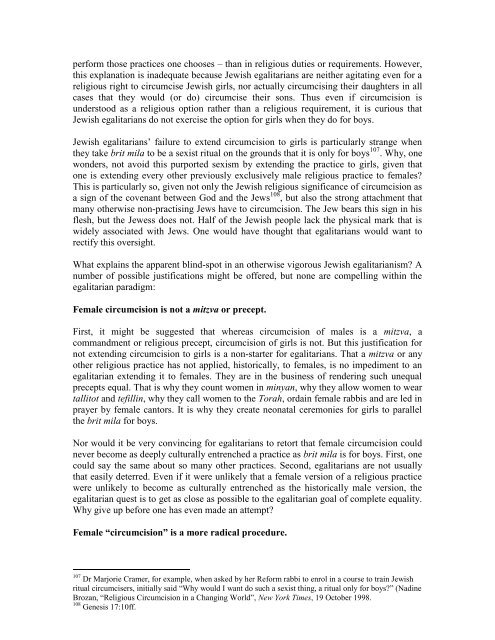ja chank 2008 - South African Jewish Board of Deputies
ja chank 2008 - South African Jewish Board of Deputies
ja chank 2008 - South African Jewish Board of Deputies
You also want an ePaper? Increase the reach of your titles
YUMPU automatically turns print PDFs into web optimized ePapers that Google loves.
perform those practices one chooses – than in religious duties or requirements. However,<br />
this explanation is inadequate because <strong>Jewish</strong> egalitarians are neither agitating even for a<br />
religious right to circumcise <strong>Jewish</strong> girls, nor actually circumcising their daughters in all<br />
cases that they would (or do) circumcise their sons. Thus even if circumcision is<br />
understood as a religious option rather than a religious requirement, it is curious that<br />
<strong>Jewish</strong> egalitarians do not exercise the option for girls when they do for boys.<br />
<strong>Jewish</strong> egalitarians’ failure to extend circumcision to girls is particularly strange when<br />
they take brit mila to be a sexist ritual on the grounds that it is only for boys 107 . Why, one<br />
wonders, not avoid this purported sexism by extending the practice to girls, given that<br />
one is extending every other previously exclusively male religious practice to females?<br />
This is particularly so, given not only the <strong>Jewish</strong> religious significance <strong>of</strong> circumcision as<br />
a sign <strong>of</strong> the covenant between God and the Jews 108 , but also the strong attachment that<br />
many otherwise non-practising Jews have to circumcision. The Jew bears this sign in his<br />
flesh, but the Jewess does not. Half <strong>of</strong> the <strong>Jewish</strong> people lack the physical mark that is<br />
widely associated with Jews. One would have thought that egalitarians would want to<br />
rectify this oversight.<br />
What explains the apparent blind-spot in an otherwise vigorous <strong>Jewish</strong> egalitarianism? A<br />
number <strong>of</strong> possible justifications might be <strong>of</strong>fered, but none are compelling within the<br />
egalitarian paradigm:<br />
Female circumcision is not a mitzva or precept.<br />
First, it might be suggested that whereas circumcision <strong>of</strong> males is a mitzva, a<br />
commandment or religious precept, circumcision <strong>of</strong> girls is not. But this justification for<br />
not extending circumcision to girls is a non-starter for egalitarians. That a mitzva or any<br />
other religious practice has not applied, historically, to females, is no impediment to an<br />
egalitarian extending it to females. They are in the business <strong>of</strong> rendering such unequal<br />
precepts equal. That is why they count women in minyan, why they allow women to wear<br />
tallitot and tefillin, why they call women to the Torah, ordain female rabbis and are led in<br />
prayer by female cantors. It is why they create neonatal ceremonies for girls to parallel<br />
the brit mila for boys.<br />
Nor would it be very convincing for egalitarians to retort that female circumcision could<br />
never become as deeply culturally entrenched a practice as brit mila is for boys. First, one<br />
could say the same about so many other practices. Second, egalitarians are not usually<br />
that easily deterred. Even if it were unlikely that a female version <strong>of</strong> a religious practice<br />
were unlikely to become as culturally entrenched as the historically male version, the<br />
egalitarian quest is to get as close as possible to the egalitarian goal <strong>of</strong> complete equality.<br />
Why give up before one has even made an attempt?<br />
Female “circumcision” is a more radical procedure.<br />
107 Dr Marjorie Cramer, for example, when asked by her Reform rabbi to enrol in a course to train <strong>Jewish</strong><br />
ritual circumcisers, initially said “Why would I want do such a sexist thing, a ritual only for boys?” (Nadine<br />
Brozan, “Religious Circumcision in a Changing World”, New York Times, 19 October 1998.<br />
108 Genesis 17:10ff.











